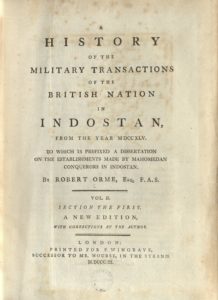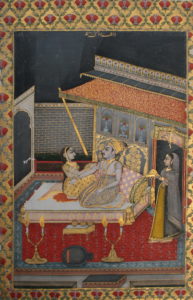To highlight some of the items and collections currently stored in the central tower of the Senate House building – and perhaps out of mind – the staff in the library will be selecting a few at regular intervals and give a brief description of the items discussed as well as their merits and limitations as historical sources.
Although 2017 has been, understandably, a busy year for historians both of the Reformation and the Russian Revolution, it does also mark a number of anniversaries in the British occupation of India. This year will mark 260 years since the Battle of Plassey, 160 years since the Indian Rebellion and 70 years since independence was won by many of the states in present day south Asia and in this and subsequent blog posts the library will showcase some of the works from the Indian history collection, describing events during those three fateful years.

Title page from volume 2 of Robert Orme’s Military Transactions
The first item is A history of the military transactions of the British nation in Indostan (London: 1803) by Robert Orme (1728–1801). Robert Orme was present in India for much of the 1750s when the British gained a significant foothold in to region. He had joined the East India Company in 1743 and by the late 1750s was a member of ruling council at Fort St. George in Chennai (Madras), and was thus among the authorities responsible for sending Robert Clive to recapture Kolkatta from the Nawab of Bengal, Siraj-ud-daulah, leading eventually to the Battle of Plassey on the 23rd June 1757. Orme gives a standard account of the battle, describing the terrain as well as the troop movements of either side in the conflict, as well as depicting the various machinations going on in Siraj-ud-daulah’s camp:
The Nabob had remained in his tent out of reach of danger, continually flattered by his attendants and officers, of whom one half were traitors, with assurances of victory; but about noon he was informed, that Meer Murdeen [Mir Madan Khan], the best and most faithful of his generals, was mortally wounded by a cannon-ball. The misfortune disturbed him to excess; he immediately sent for Meer Jaffier [Mir Jafar]; and as soon as he entered the tent, flung his turban on the ground, saying, “Jaffier, that turban you must defend.” The other bowed, and with his hands on his breast, promised his utmost services; and returning to his troops and associates, immediately dispatched a letter to Colonel Clive…In the meantime, the terrors of the Nabob increased continually: Roydoolub [Rai Durlabh] taking advantage of them, counselled him to return to his capital: his advice prevailed, and the Nabob ordered the army to retreat into the intrenchments. (Vol. II, p. 175)
The rest of Orme’s account describes how the British forces attacked the retreating part of the Nawab’s army, Clive’s belated recognition that one of the lingering divisions was Mir Jaffar’s, as well as the British forces eventual capturing of the Nawab’s camp in the late afternoon of June 23rd. Orme also describes how Siraj-ud-Daulah was captured for Mir Jafar’s forces as well as his eventual execution only a few weeks after the battle on July 2nd. He concludes that Siraj-ud-Daulah’s defeat was largely due to alienating forces in his own court rather than any perceived military prowess on the side of the British:
Tyrant as he was, if he had respected the advice of his grandfather Allaverdy [Ali Vardi 1671–1756], and not have excited the detestation of the Gentoos, at the same time that he was rendering himself dreadful to the principal Mahomedan officers of his court, the English would have found no alliance sufficient to have ventured the risque of dethroning him: but it is probable that the same iniquity of character, which urged him to the destruction of Calcutta, would soon have called forth other avengers of other atrocious deeds (Vol. II, p. 185)

Portrait of Siraj-ud-Daulah
Orme’s account is, obviously, limited, being both a classic example of history from the victor’s perspective as well as dripping with preconceived orientalist notions of someone entrenched in the conquest-capitalism of the East India Company. Understandably, this does not diminish its value as a source. Although one could rightly doubt many aspects of Orme’s account of eighteenth century India, the implicit details and assumptions conveyed by his narrative tells us probably more about British attitudes to India, conquest and race than is does about the events of 1757.
If you would like to consult this work yourself, or any others from the library’s collections of works on India from the 18th to the early 20th century, just contact the library office at ihr.library@sas.ac.uk or come along in person, we’re on the first floor. Try a search of the catalogue to find out what other items we have.
